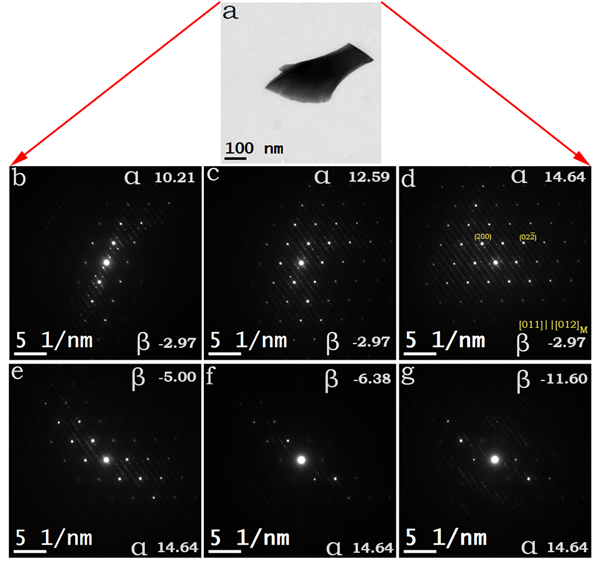Electron diffraction studies of commensurately modulated structures in bismuth transition metal oxide
- Abstract number
- 79
- Presentation Form
- Poster Flash Talk + Poster
- DOI
- 10.22443/rms.mmc2021.79
- Corresponding Email
- [email protected]
- Session
- Stream 2: EMAG - Electron Crystallography and Diffraction
- Authors
- Mr Satyam Choudhury (2), Mr Vishnumahanthy Mohan (2), Mr Hriddhi Ghosh (2), Mr Avnish Pal (2), Dr. Manish Singh (1), Prof. Rajiv Mandal (2), Dr. Joysurya Basu (2)
- Affiliations
-
1. Department of Materials Science & Engineering, University of Connecticut
2. Department of Metallurgical Engineering, Indian Institute of Technology (BHU)
- Keywords
Electron diffraction, Commensurate modulation, Crystallography, Stereogram
- Abstract text
Bismuth transition metal oxides (Bi-M-O, M = Cr, Mn) are well known for their multiferroic properties. Understanding multiferroic properties is dependent on our ability to resolve structure as well as chemistry of the resulting phases during synthesis. One of the issues pertaining to structure in this system relates to nature of commensurate modulation. One of the primary motivations of this investigation will be to understand nature of commensurate modulation along various crystallographic directions. The tool utilised for this purpose will be electron diffraction and related contrast imaging.
Synthesis of Bi-Cr-O and Bi-Mn-O compounds was done through solid state as well as through wet chemical routes. Powders obtained by these routes were drop cast on to the lacy carbon grid and then the specimen was placed inside double tilt holder in FEI Technai G2 T20 Transmission Electron Microscope (TEM) operated at 200 KV, to carry out investigation by complementary electron diffraction experiments through systematic tilting. Simulations of stereograms were carried out through JEMS.
Selected area electron diffraction (SADP) patterns were acquired from an appropriate specimen volume by adjusting the aperture diameter to ~0.5micron. It is observed that the diffraction patterns display variation of intensities. Aligning the electron beam confirming to a zone we were able to acquire the diffraction pattern. It is observed there is a systematic change in intensity indicating presence of commensurate modulation. After getting clear signature of diffracted spot representing symmetry of basic and modulated unit we established orientation relationship between them by overlaying stereogram corresponding to both the units. The simulated stereogram assembly act as a model to identify set of overlapping poles corresponding to basic and modulated units, inspection along such axis enable us to acquire diffraction pattern with clear signature of basic and modulated units. Validity of the simulated model has been approximately verified by obtaining series of complementary diffraction patterns through tilting at different orientations. Additionally this enables us to determine the structure of the basic unit, the nature and extent of modulation along specific crystallographic directions in these compounds. Signature of lattice fringes corresponding to planes of commensurately modulated unit was captured at relatively lower magnification by diffraction contrast imaging. Inspection along zone axis of commensurately modulated unit enables us to acquire diffraction pattern containing signature of higher order Laue zones (HOLZ). As the lattice parameter along z axis is quite large, it is possible to capture several Laue zones simultaneously. Signature of micro twin and in-plane rotational twin boundaries had been observed through electron diffraction. Signature of commensurately modulated unit and basic unit has been obtained through convergent beam electron diffraction. The symmetry of basic and modulated unit has been analysed.
Precise alignment of electron beam is the key to reveal unique structural features associated with commensurately modulated Bi-Cr/Mn-O compounds through electron diffraction. Diffraction signature of modulated unit could be independently obtained with or without signature of basic unit along specific direction however, the signature of basic unit cannot be obtained exclusively.
Figure 1 - Systematic tilting of the particle as shown in the bright field (BF) image (a) at different angular values of α and β (in degree) were listed in the series of acquired diffraction patterns shown in fig. 1 (b) to (g). At a particular orientation we were able to acquire diffraction pattern where [011] Zone Axis (ZA) of basic unit is oriented parallel to [012]M ZA of modulated unit corresponding to commensurately modulated Bi10Cr2O21 compound. However, in rest of the SADP acquired off the zone axis the diffraction signature appears complex with inhomogeneous distribution of diffracted intensities.
- References
[1] Hill et al., J. Phys. Chem. B, vol. 106, no. 13, pp. 3383–3388, 2002.
[2] Grins et al., J. Solid State Chem., vol. 163, no. 1, pp. 144–150, 2002.
[3] D. B. Williams and C. B. Carter, Transmission Electron Microscopy, vol. 5, no. 721. 2009.
[4] The authors would like to acknowledge the financial support from UGC-DAE-CSR by the award number CSR-KN/CRS-94/2017-18/282.
[5] The author would like to acknowledge the support from Department of Science & Technology inspired FIST programme.

